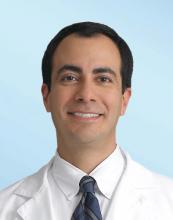WASHINGTON – Hepatoxicity from herbal and dietary supplements is on the rise in the United States, with body-building supplements being implicated as the most common cause of liver injury, according to the results of a recent study.
Between September 2004 and March 2013, 845 cases of liver injury were thought to be "definitely, highly likely, or probably" from an herbal or dietary supplement, or from prescription drugs. Of these cases, 136 (16%) were attributed to a product in the herbal and dietary supplement category. Patients reported consuming a total of 262 different herbal and dietary supplements; 30% were body-building products. Cases of liver injury from all herbal and dietary supplements increased from 7% in 2004-2005 to 20% in 2010-2012, reported Dr. Victor J. Navarro at the annual meeting of the American Association for the Study of Liver Diseases.
The prospective study used data from the Drug-Induced Liver Injury Network (DILIN). The network was established in 2003 by the National Institute of Diabetes and Digestive and Kidney Diseases to collect and analyze cases of severe liver injury caused by prescription and over-the-counter drugs, as well as alternative medications, including herbal products and supplements.
Of the hepatotoxicity cases due to supplements, 7 were excluded because they involved both body-building and other herbal and dietary supplements. Of the remaining 129 cases, 44 were attributed to body-building supplements and 85 cases were attributed to other types of herbal and dietary supplements. These cases were compared with 709 cases of drug-induced liver injury, noted Dr. Navarro, chair of the division of hepatology, Einstein Healthcare Network, Philadelphia.
Clinical features and demographic characteristics differed between the groups. The 44 patients with injury induced by body-building supplements were younger (mean age 33 years, vs. 48-50 years in the other two groups), and all were men. In the other two groups, 35%-37% of cases occurred in men.
As for clinical presentation, "the body-building supplement injury cases stood apart," as there was a "distinct presentation of prolonged jaundice," Dr. Navarro noted. "These patients tended to have fewer comorbid conditions," were heavier, and were "uniformly symptomatic." They all had jaundice, and 84% had pruritus. Of patients in the other herbal and dietary supplement group, 78% presented with jaundice and 48% presented with pruritus, compared with and 68% and 53%, respectively, of those with drug-induced liver injury.
Body-building liver injury cases required hospitalization more often, but no patients in this group died or had a liver transplant. There were deaths from all causes in the two other groups, but the differences were not significant. However, 13% of the cases of liver injury from other supplements resulted in a liver transplant, compared with 3% among the drug-induced liver injury group, a significant difference.
The higher transplant rate indicates that the hepatoxicity induced by non-body-building supplements "may be more severe" than injury induced by prescription drugs, Dr. Navarro observed.
Other marked differences between the groups included a serum total bilirubin that was significantly higher and persisted significantly longer in patients with liver injury from body-building supplements.
Although the study results indicate that hepatotoxicity due to herbal and dietary supplements is increasing, this was not a population-based study, and so "additional efforts to characterize the true burden of disease in the U.S. population are needed," and are being addressed by DILIN, Dr. Navarro said.
The National Institutes of Health sponsored the study. Dr. Navarro had no relevant disclosures. Information about DILIN is available here.

